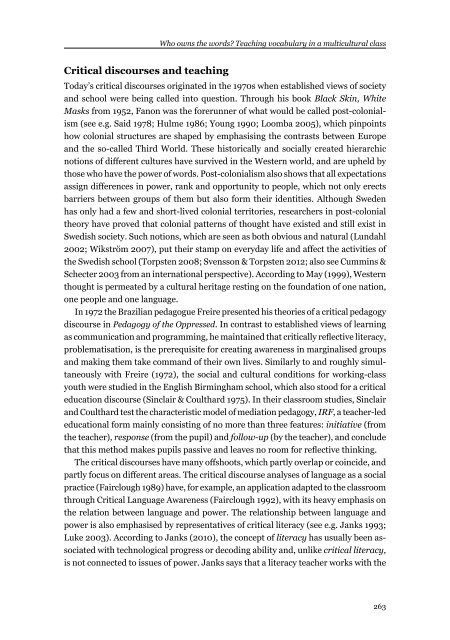Download issue - Umeå universitet
Download issue - Umeå universitet
Download issue - Umeå universitet
Create successful ePaper yourself
Turn your PDF publications into a flip-book with our unique Google optimized e-Paper software.
Who owns the words? Teaching vocabulary in a multicultural class<br />
Critical discourses and teaching<br />
Today’s critical discourses originated in the 1970s when established views of society<br />
and school were being called into question. Through his book Black Skin, White<br />
Masks from 1952, Fanon was the forerunner of what would be called post-colonialism<br />
(see e.g. Said 1978; Hulme 1986; Young 1990; Loomba 2005), which pinpoints<br />
how colonial structures are shaped by emphasising the contrasts between Europe<br />
and the so-called Third World. These historically and socially created hierarchic<br />
notions of different cultures have survived in the Western world, and are upheld by<br />
those who have the power of words. Post-colonialism also shows that all expectations<br />
assign differences in power, rank and opportunity to people, which not only erects<br />
barriers between groups of them but also form their identities. Although Sweden<br />
has only had a few and short-lived colonial territories, researchers in post-colonial<br />
theory have proved that colonial patterns of thought have existed and still exist in<br />
Swedish society. Such notions, which are seen as both obvious and natural (Lundahl<br />
2002; Wikström 2007), put their stamp on everyday life and affect the activities of<br />
the Swedish school (Torpsten 2008; Svensson & Torpsten 2012; also see Cummins &<br />
Schecter 2003 from an international perspective). According to May (1999), Western<br />
thought is permeated by a cultural heritage resting on the foundation of one nation,<br />
one people and one language.<br />
In 1972 the Brazilian pedagogue Freire presented his theories of a critical pedagogy<br />
discourse in Pedagogy of the Oppressed. In contrast to established views of learning<br />
as communication and programming, he maintained that critically reflective literacy,<br />
problematisation, is the prerequisite for creating awareness in marginalised groups<br />
and making them take command of their own lives. Similarly to and roughly simultaneously<br />
with Freire (1972), the social and cultural conditions for working-class<br />
youth were studied in the English Birmingham school, which also stood for a critical<br />
education discourse (Sinclair & Coulthard 1975). In their classroom studies, Sinclair<br />
and Coulthard test the characteristic model of mediation pedagogy, IRF, a teacher-led<br />
educational form mainly consisting of no more than three features: initiative (from<br />
the teacher), response (from the pupil) and follow-up (by the teacher), and conclude<br />
that this method makes pupils passive and leaves no room for reflective thinking.<br />
The critical discourses have many offshoots, which partly overlap or coincide, and<br />
partly focus on different areas. The critical discourse analyses of language as a social<br />
practice (Fairclough 1989) have, for example, an application adapted to the classroom<br />
through Critical Language Awareness (Fairclough 1992), with its heavy emphasis on<br />
the relation between language and power. The relationship between language and<br />
power is also emphasised by representatives of critical literacy (see e.g. Janks 1993;<br />
Luke 2003). According to Janks (2010), the concept of literacy has usually been associated<br />
with technological progress or decoding ability and, unlike critical literacy,<br />
is not connected to <strong>issue</strong>s of power. Janks says that a literacy teacher works with the<br />
263

















